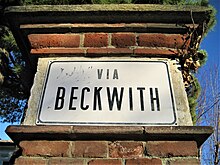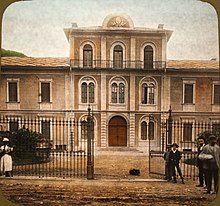Torre Pellice
| Torre Pellice | ||
|---|---|---|

|
|
|
| Country | Italy | |
| region | Piedmont | |
| Metropolitan city | Turin (TO) | |
| Coordinates | 44 ° 49 ' N , 7 ° 14' E | |
| height | 516 m slm | |
| surface | 21 km² | |
| Residents | 4,543 (Dec 31, 2019) | |
| Population density | 216 inhabitants / km² | |
| Post Code | 10066 | |
| prefix | 0121 | |
| ISTAT number | 001275 | |
| Popular name | torresi | |
| Patron saint | San Martino | |
Torre Pellice ( Piedmontese la Tor, Occitan la Toure de Pèlis ; formerly Torre di Luserna ) is a small town and municipality with 4543 inhabitants (as of December 31, 2019) in the Italian metropolitan city of Turin (TO), Piedmont region . Torre Pellice was the capital of the three historic Waldensian valleys in the Cottian Alps ( Val Pellice , Val Chisone and Valle Germanasca ) and is still the center of the Chiesa Valdese italiana, the (Protestant) Waldensian church in Italy. On April 7, 2017, Torre Pellice was the 96th city to be officially awarded the honorary title “City of the Reformation of Europe ” by the Community of Evangelical Churches in Europe .
geography
The place is 40 km southwest of Turin in the lower Val Pellice - about 15 km from the confluence of the Pellice in the Po - at an altitude of 516 m above sea level. The neighboring municipalities are Angrogna , Villar Pellice , Luserna San Giovanni and Rorà . The next bigger town is Pinerolo .
The municipality covers an area of 21 km². Not far from Torre Pellice and almost always visible from there is the approx. 2100 m high Monte Vandalino with the lower Castelluzzo on its south-eastern mountain flank. Below the Castelluzzo is the Borgata Bonnet belonging to Torre Pellice (the "Borgate" are very small mountain villages, which usually belong to a larger municipality). If you descend from here into the valley, you will reach the district of Santa Margherita.
history
middle Ages
The name Torre Pellice goes back to a residential tower built around the year 1000 on a hill above the Pellice river. In the 13th century, a feudal lord Rorenghi, who belonged to the count family of Luserna, resided here.
Petrus Waldes and his followers, the "poor of Lyon", were excommunicated by the Catholic Church in Lyon in 1184 and persecuted by the Inquisition from 1231 onwards . The refugees settled in various places in southern France and northern Italy, including before 1300 in Torre Pellice and the surrounding area in the Cottian Alps. Around 1400 they were also persecuted in Torre Pellice and some therefore fled to the area around Avignon or to Guardia Piemontese in Calabria .
Reformation and Counter Reformation
Evangelical ideas from Martin Luther and other reformers reached Torre Pellice and the surrounding villages as early as 1520. A few years later, a Waldensian group was sent to Switzerland to get an idea of the beginning Reformation . On September 12, 1532, a meeting with the Swiss reformer Guillaume Farel took place in Chanforan in the Angrogna Valley, which is only a few kilometers above Torre Pellice. At this “Synod of Chanforan” it was decided that the loose Waldensian movement should become a reformed church. Some principles such as poverty, preachers celibacy, rejection of the oath, and secular rule had to be abandoned. The Waldensians then joined the Reformation of Geneva and its church order, which were largely shaped by Guillaume and Jean Calvin . As a result, a complete French translation of the Bible was created by Pierre-Robert Olivétan , evangelical pastors trained in Geneva were employed and the first simple and unadorned church building was built, which was called Tempio .
The Waldensians of Torre Pellice and the surrounding area were able to resist the Duke of Savoy in 1561 and obtain limited tolerance. But in the 17th century they were subjected to further persecutions, oppression and expulsions from the ruling Savoy. Particularly cruel were those battles around Easter 1655, called Pasqua piemontese , when the Savoy army sacked the country, which affected 279 families. Also in 1686 the Waldensians defended themselves against 8,500 Savoy and French soldiers. In September they had to surrender in order to be able to emigrate to Switzerland. The refugees were also accepted in Baden , Württemberg and Hesse . The desire to return to Torre Pellice and the valleys remained, however, Il Glorioso rimpatrio (French: glorieuse rentrée , German: the glorious return ) could be carried out from 1689 to 1690 under the leadership of Pastor Henri Arnaud . The hardships and bloody struggle of the Waldensians for survival had also triggered protests, solidarity and financial support from the Netherlands and England, which helped to ensure a narrow survival on the ground. The former British army officer John Charles Beckwith (1789-1862) went to Torre Pellice after 1820 and helped build 120 schools and some Waldensian church buildings. The street at Casa Valdese and Tempio Nuovo is named after him.
Modern times
It was not until 1848 that the Waldensians in Piedmont were granted full civil rights, which has been celebrated every year since then. From 1849 to 1852 the Tempio Nuovo , a large new Waldensian church, was built in Torre Pellice . From 1859 houses for the pastor and the teachers of the grammar school followed. The “Tavola Valdese”, the Waldensian Synod, has met annually in the “Casa Valdese” since 1889, and it determined the course of the Waldensian Church then and still today. Thanks to donations, a university could be built in the village, but it was moved to Rome as early as 1922.
After 1700, the development of the village increased with the construction of canals and factories along the Pellice River to use its water and hydropower. In 1882 a railway line from Pinerolo with a terminus at Torre Pellice was opened, which significantly improved the economic connection, so that the working population increased sharply - the railway connection was discontinued in 2012. While Torre Pellice had 2,343 inhabitants in 1819, there were 6,000 in 1900, even though many poor families had emigrated to South America.
20th century (fascism and World War II)
In 1938, after the anti-Jewish racial laws were introduced, many Waldensians in Torre Pellice supported and accepted Jews and other politically persecuted people. After September 8, 1943, many of the persecuted joined the partisans against the German occupation. Il Pioniere, its own underground newspaper, was printed in the Pellice Valley. The best-known activist of the Resistance and refugee aid workers was the engineer Willy Jervis, who was captured by the Germans on March 11, 1944 and shot on August 5, 1944 in Villar Pellice. A memorial stone on site, a memorial in Torre Pellice and the library of the resistance with the name Carlo Levi , which is housed in the former SS barracks and contains over 2000 books, commemorate the people involved and the courageous struggle of the Resistancea.
Waldensian institutions, buildings and places of remembrance
The Tempio dei Coppieri is located in Santa Margherita , one of the three Waldensian churches in Torre Pellice.
The Waldensian institutions are located in the western part of the main town of Torre Pellice, facing the head of the valley, along Via Beckwith: These include the building of the Fondazione Centro Culturale Valdese, founded in 1989 by the Tavola Valdese and the Società di studi valdesi , which includes the following facilities:
- the library of the Waldensian Cultural Center Foundation with around 85,000 books
- two museums: one ethnographic and one historical, which deals with the history of the religious minority church whose origins go back to the twelfth century and are thus around three hundred years older than Luther's Reformation
- a hall for temporary exhibitions
- a collection of paintings by the Waldensian painter Paolo Paschetto
- an archaeological collection (Sala Ippolito)
- the tourist office "Il Barba" (Occitan for "uncle", as the medieval preachers of the Waldenses were called)
- the Archivio della Tavola valdese with around 35,000 photos.
Directly opposite is the Tempio Nuovo, the construction of which began in the 1850s on the initiative of the English general John Charles Beckwith , one of the great supporters of the Waldensians. A little further in the direction of the town center, you come across the Casa Valdese, in which the synodal hall houses a fresco by the Waldensian painter Paolo Paschetto . A few meters further east is a bronze statue of Henri Arnaud , the pastor who brought the Waldensians back into the valleys in 1689 during the so-called “Glorious Return” ( Glorioso Rimpatrio ) from three years of exile.
Town twinning
-
 Germany , Mörfelden-Walldorf , Hessen , since 1999. - In 1699 Walldorf was founded and built up by 14 refugee Waldensian families.
Germany , Mörfelden-Walldorf , Hessen , since 1999. - In 1699 Walldorf was founded and built up by 14 refugee Waldensian families.
literature
- Sabine Bade, Wolfram Mikuteit: Partisan Paths in Piedmont. Places and paths of resistance between Gran Paradiso and Monviso. Querwege Verlag, Konstanz 2012, ISBN 978-3-941585-05-8 .
- Armando Tallone: Torre Pellice. In: Enciclopedia Italiana di scienze, lettere ed arti. Volume 34: Topo-Ved. Istituto della Enciclopedia Italiana , Roma 1937, OCLC 889189925 ( treccani.it ).
- Sara Tourn: Torre Pellice. La "Ginevra italiana" attraverso i secoli. Claudiana, Turin 2013, ISBN 978-88-7016-964-5 .
Web links
- "Bibliografia Valdese" (also in German)
- Liceo Valdese website (Italian)
- Commune website (Italian)
- Information at comuni-italiani.it (Italian)
- Website of the Waldensian Museum of the Centro Culturale Valdese (Italian)
- Paolo Tognina: A spasso nelle Valli Valdesi. Torre Pellice e Val d'Angrogna - Sulle tracce della storia e della cultura dei Valdesi. In: RSI (Swiss television in Italian). September 28, 2013 (Italian)
Individual evidence
- ↑ Statistiche demografiche ISTAT. Monthly population statistics of the Istituto Nazionale di Statistica , as of December 31 of 2019.
- ↑ a b Marco Cogno: Reformation city Torre Pellice - The world capital of the Waldensians. In: reformation-cities.org/cities, accessed March 3, 2018.
- ↑ Torre Pellice è “città europea della Riforma”. In: nev.it. Notie Evangeliche, April 10, 2017, accessed April 15, 2017.
- ↑ a b Comune Torre Pellice - La storia. (No longer available online.) In: torrepellice.to.it. January 28, 2014, archived from the original on July 4, 2016 ; accessed on May 19, 2019 (Italian).
- ↑ Bible d'Olivétan 1535. (No longer available online.) In: levigilant.com. Archived from the original on October 2, 2018 ; accessed on May 19, 2019 (French).
- ↑ Il quartiere valdese , website comune.torrepellice.to.it (Italian)
- ↑ Storia e Monumenti di Torre Pellice. In: prolocotorrepellice.it. Associazione Turistica Proloco Torre Pellice, 2016, accessed March 2, 2018.
- ↑ Torre Pellice on gedenkorte-europa.eu, the homepage of Gedenkorte Europa 1939–1945 , accessed on March 3, 2018.
- ↑ To this in detail Il Tempio dei Coppieri (Torre Pellice). ( Memento of March 3, 2018 in the Internet Archive ) (PDF; 98 kB) In: torrepellice.chiesavaldese.org. Chiesa Valdese di Torre Pellice, accessed April 29, 2017.
- ↑ a b c d e f g Cf. for example Fondazione Centro Culturale Valdese. In: fondazionevaldese.org, accessed April 9, 2016.
- ↑ Cf. Osvaldo Coisson: Angrogna. The story of a Waldensian community. Translated by Robert Zwilling. Fusta, Angrogna 2013, ISBN 978-88-95163-98-7 , p. 21 (original title: La storia di Angrogna ).
- ^ Il Tempio Nuovo di Torre Pellice. ( Memento of September 26, 2017 in the Internet Archive ) (PDF; 73 kB) In: torrepellice.chiesavaldese.org. Chiesa Valdese di Torre Pellice, accessed April 29, 2017.
- ↑ Torre Pellice. In: freundeskreis-staedtepartetzung.eu. Freundeskreis town twinning e. V. Mörfelden-Walldorf, accessed on March 3, 2018.






